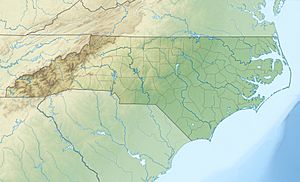Dry Creek (Cape Fear River tributary) facts for kids
Quick facts for kids Dry Creek |
|
|---|---|
|
Location of Dry Creek Creek mouth
|
|
| Other name(s) | Tributary to Cape Fear River |
| Country | United States |
| State | North Carolina |
| County | Harnett |
| Physical characteristics | |
| Main source | Buies Creek divide about 4 miles northeast of Lillington, North Carolina 272 ft (83 m) 35°27′52″N 078°47′15″W / 35.46444°N 78.78750°W |
| River mouth | Cape Fear River about 0.25 miles north of Lillington, North Carolina 108 ft (33 m) 35°24′06″N 078°47′50″W / 35.40167°N 78.79722°W |
| Length | 6.03 mi (9.70 km) |
| Basin features | |
| Progression | generally south |
| River system | Cape Fear River |
| Basin size | 4.70 square miles (12.2 km2) |
| Tributaries |
|
| Bridges | Harnett Central Road, Dry Creek Road, Old Coats Road, US 421-NC 27 |
Dry Creek is a small stream, about 6.03 mi (9.70 km) long, located in Harnett County, North Carolina. It flows into the larger Cape Fear River. Think of it as a smaller helper stream that adds its water to a bigger river.
Contents
Where Dry Creek Flows
Starting Point
Dry Creek begins its journey about 4 miles (6.4 km) north of a town called Lillington, North Carolina. This is where the water first gathers to form the creek.
Path to the River
From its start, Dry Creek flows mostly towards the south. It travels through the land, collecting more water as it goes.
Joining the Cape Fear River
Finally, Dry Creek meets and joins the Cape Fear River. This meeting point is about 0.25 miles (0.4 km) northeast of Lillington.
Understanding the Watershed
What is a Watershed?
A watershed is like a big bowl of land where all the rain and snow that falls drains into a specific river or stream. For Dry Creek, its watershed is the area of land that sends water into the creek.
Dry Creek's Watershed Area
The land area that drains into Dry Creek is about 4.70 square miles (12.2 km2). This means all the rain and water that falls on this specific area will eventually flow into Dry Creek.
Rainfall and Forests
This area gets about 46.1 inches (117 cm) of rain each year. About 24% of the land in Dry Creek's watershed is covered by forests. Forests are important because they help keep the water clean and prevent soil from washing away.



